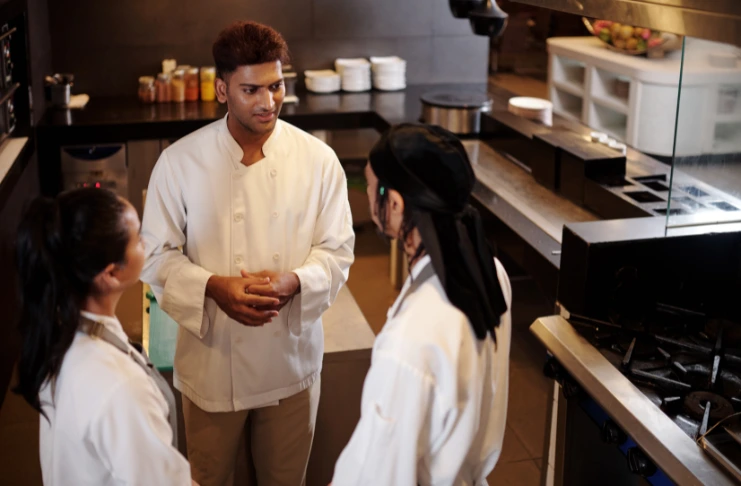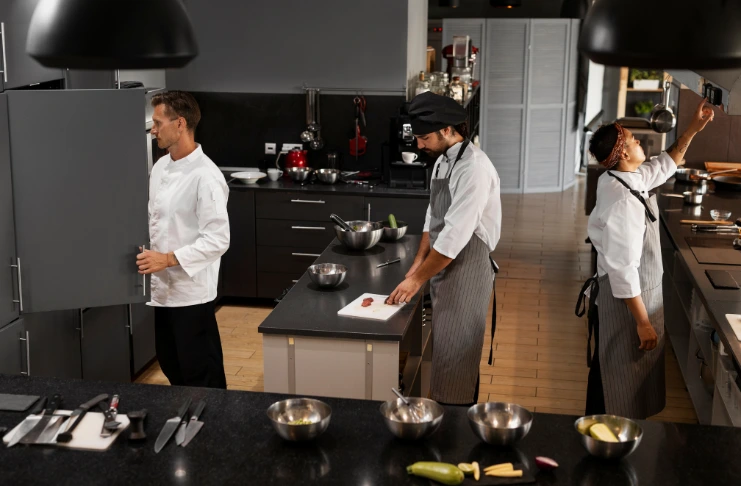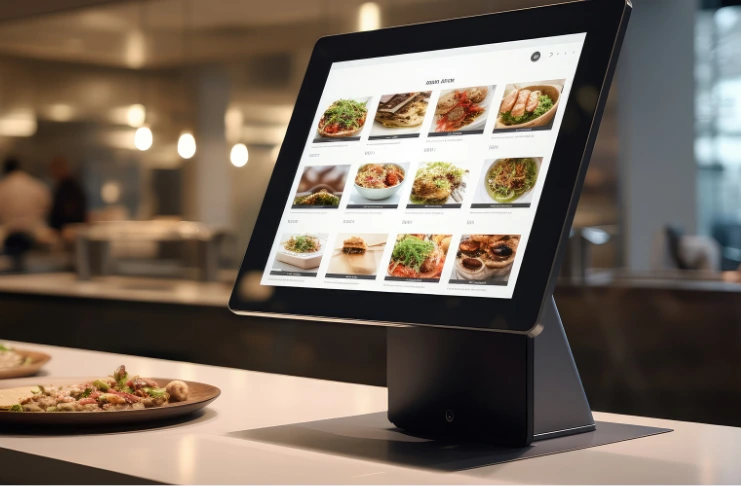
Running a restaurant kitchen is like conducting an orchestra—every person, tool, and process must work in harmony to produce a consistent, high-quality dining experience. Whether you’re managing a fine dining establishment or a quick-service outlet, the success of your restaurant often comes down to the efficiency of your kitchen. It’s not just about great food; it’s about how smoothly it gets to your customers in the dining room —hot, accurate, and timely.
An efficient kitchen minimizes chaos, reduces waste, and helps maintain food consistency, all while controlling labor and operational costs. This blog walks you through every major component of running a smooth, high-performing restaurant kitchen and effective foodservice operations , from layout planning and process standardization to inventory control and kitchen staff management.
Defining Kitchen Efficiency: What It Really Means
An efficient kitchen is one where every square foot of space and every second is optimized to deliver maximum output with minimal waste. It’s a kitchen where chefs don’t bump into each other, ingredients are always stocked and easy to locate, and orders flow seamlessly from ticket to table. More importantly, efficient kitchens consistently serve quality food during busy periods while maintaining hygiene, safety, and speed.
Key characteristics of an efficient restaurant kitchen include:
- Minimal Waste & Maximum Productivity: Proper inventory management ensures that food ingredients are utilized optimally, reducing wastage and controlling costs.
- Streamlined Workflow: Kitchen layouts and processes should enable seamless movement, minimizing delays and inefficiencies.
- Well-Coordinated Staff: The team should be well-trained in their respective roles, ensuring coordination between chefs, servers, and cleaning staff.
- Use of Technology: From digital order management systems to smart kitchen equipment, the right technology enhances efficiency.
- Customer Satisfaction: Speed and quality of service ensure customers receive their meals without unnecessary delays.
Key Elements to Run Your Restaurant Kitchen More Efficiently
1. Standard Operating Procedures (SOPs)
Creating clear kitchen procedures and SOPs for every task in your restaurant kitchen sets the foundation for operational consistency. From preparing each dish to cleaning the grill or storing perishable items, SOPs ensure that kitchen staff don’t rely on guesswork.
For example, a burger chain might have a detailed SOP for assembling a cheeseburger—bun toasted for 30 seconds, patty cooked to 165°F, exact cheese placement, and specific garnishing. This ensures a uniform customer experience across locations and minimizes food waste and rework.
SOPs should cover:
- Food preparation methods
- Cleaning and sanitation practices
- Safe handling and storage of kitchen equipment
- Closing and opening procedures
Training every team member, including the head chef, to follow these SOPs is essential to maintaining efficiency, especially during peak hours.

2. Kitchen Layout and Workflow Optimization
The physical space in a restaurant kitchen directly impacts productivity and safety. Poorly designed kitchens lead to bottlenecks, miscommunication, and accidents.
An optimized kitchen layout should support a logical workflow—from receiving ingredients to prepping, cooking, plating, and cleaning. Depending on your service style, you can adopt layouts like:
- Assembly Line Layout (great for QSRs)
- Zone-Style Layout (ideal for fine dining or large operations)
- Island Layout (offers high visibility and team coordination)
Investing in ergonomic design, proper ventilation, and strategically placed kitchen equipment, like refrigeration near prep stations or fryers near the plating area, can significantly boost efficiency.
For instance, a pizza kitchen can improve throughput by placing the dough station right beside the toppings counter and the oven, reducing back-and-forth.
3. Inventory and Stock Management
Your kitchen is only as good as its ability to consistently deliver food. That requires having the right ingredients at the right time without overstocking. Effective inventory management ensures you’re never out of essentials or stuck with expired goods.
Key tips for efficient inventory management:
- Use the FIFO (First-In, First-Out) method for perishables
- Set par levels to avoid over-purchasing
- Conduct weekly inventory audits and log waste
- Digitize stock tracking using POS-integrated technology
For example, using software that links recipes to ingredient levels can alert a restaurant when a key item like mozzarella is running low, allowing timely restocking and preventing menu gaps. Good inventory control also improves profitability by reducing food waste of menu items and better predicting purchasing needs.
INDUSTRY INSIGHT
58% of retail brands and manufacturers have below 80% inventory accuracy, often due to outdated systems and poor data management.
The report suggests that key factors affecting accuracy include frequent ERP software updates, legacy system integration issues, and a lack of centralized data management, making efficient inventory control essential for operational success.
4. Recipe Standardization and Portion Control

In the hospitality business, consistency in food quality is non-negotiable. To maintain that consistency, you must standardize every recipe and tightly control portion sizes.
Recipe cards should include:
- Ingredient list with exact quantities
- Preparation instructions
- Cooking time and temperature
- Plate presentation guidelines
A recipe management software helps many restaurants maintain precise portion control by standardizing ingredient measurements across all dishes. It enables chefs to track ingredient usage across several recipes , minimize waste, and ensure consistent food quality, ultimately improving cost efficiency and kitchen operations.
For example, a standardized pasta dish should always contain 180 grams of spaghetti, 120 grams of sauce, and 15 grams of grated cheese—not more, not less. This improves efficiency and ensures kitchen staff can maintain quality even during busy shifts.
5. Food Safety and Sanitation Practices
Cleanliness in a restaurant kitchen is a legal requirement and a business imperative. An outbreak due to poor hygiene can tarnish your brand overnight and compromise high-quality service.
Key hygiene best practices include:
- Regular sanitization of all kitchen equipment and surfaces
- Maintaining separate stations for raw and cooked foods
- Personal hygiene protocols for kitchen staff (gloves, hairnets, uniforms)
- Proper storage of meats, dairy, and other perishables
Invest in color-coded cutting boards, temperature monitoring tools, and cleaning checklists. Assign clear accountability for daily sanitation tasks and perform spot checks to ensure compliance.
6. Use Technology to Streamline Operations

Modern restaurant kitchens need to embrace technology to compete. From tracking orders, including online ordering, to managing staff schedules and maintaining inventory, smart tools improve control and decision-making.
Key technologies to adopt:
- POS Systems integrated with kitchen printers or Kitchen Display Systems (KDS)
- Inventory management software that tracks usage trends
- Time-tracking and scheduling tools for kitchen staff
- Recipe and cost control tools to improve margins
Example: A fast-casual restaurant using a kitchen display system can route online and dine-in orders directly to the right station, reducing wait time and boosting efficiency. Even simple tools like digital temperature logs or smart timers can help maintain consistency and safety standards.
7. Staff Management and Communication in the Kitchen
Your kitchen staff is your biggest asset. Hiring the right people, training them properly, and creating open lines of communication are crucial for smooth operations.
Best practices for managing kitchen staff:
- Hire for both technical skill and attitude
- Provide structured onboarding and regular upskilling
- Conduct daily pre-service briefings to align on specials, expected covers, or changes
- Encourage FOH and BOH collaboration to ensure smooth handoffs
Conclusion
Running a successful restaurant kitchen is equal parts art and logistics. It takes the right people, well-placed kitchen equipment, structured processes, and modern technology to create a high-performance back-of-house operation. The goal is not just to cook great food but to do it consistently, quickly, safely, and profitably—no matter the size of your space or the volume of customers.
By focusing on these foundational areas—SOPs, layout optimization, inventory control, standardization, hygiene, tech adoption, and team management—you can build the kind of efficient kitchen that drives repeat business and improves your bottom line.
Frequently Asked Questions
Focus on staff training, SOPs, efficient layout, inventory control, and using technology to streamline operations.
The Executive Chef or Kitchen Manager or Restaurant Manager is responsible for overseeing all restaurant kitchen operations. They ensure efficient workflow, manage kitchen team, maintain food quality, and enforce hygiene standards.
With clear roles, structured workflows, recipe standardization, and consistent communication among staff.
A major mistake in a restaurant kitchen is the lack of standardized procedures, which leads to inconsistent food quality and inefficiency. Poor communication among kitchen staff causes delays and errors.
Keep it clean and organized, and follow food safety practices at all times.
Through efficient processes, a skilled team, good kitchen layout, and effective use of technology.
Safety first—both food safety and physical safety for staff.
To manage a restaurant kitchen efficiently, define clear roles for house staff, implement Standard Operating Procedures (SOPs), track performance, and optimize inventory control. Foster teamwork through open communication and training programs.
Ensure consistency, control costs, maintain hygiene, and empower your kitchen staff with the right tools and training.
Optimize space, standardize operations, track inventory, and use digital systems to manage orders and performance.
Enhancing kitchen efficiency requires streamlining workflows, optimizing space, and minimizing clutter. Standardize recipes to maintain consistency and implement portion control techniques to boost sales. Use automation tools like Recipe Management Software and inventory tracking systems.
Yes, if managed well with tight control on costs, waste, and staffing—profitability is highly achievable.








